 |
| yes, it's full of worms |
Our is a little warped, so you have to push the lid down firmly before twisting it into locked position for tumbling (you do not want the top coming off when it's upside down.)
What can go in the composter:
All organic materials contain carbon and nitrogen in varying proportions. To create ideal conditions for composting, add and mix equal parts (by volume) of "green" high-nitrogen materials and "brown" high-carbon materials. This blend will provide the bacteria and other decomposer organisms the proper proportions of carbon and nitrogen.
Greens are fresh, moist, nitrogen-rich plant materials that still have some life in them (fruit and vegetable scraps, coffee grounds, tea bags, fresh leaves, yard prunings, etc.).
Browns are dry, carbon-rich plant materials with no life in them (fall leaves, shredded paper, straw, wood chips, twigs, etc.).
Remember, you want to keep a balance between the materials in the "greens" list and the "browns" list. Without enough greens, a pile will decompose very slowly, and without enough browns the pile may smell bad. In general, it's better to err on the side of too many browns, so you should stockpile dry, carbon-rich material, such as fall leaves or shredded newspaper, to add to your bin throughout the year.
Complete List of Greens and Browns
GREENS
(materials rich in nitrogen) |
BROWNS
(materials rich in carbon) |
From Your Garden - green plants - garden trimmings - fresh leaves & flowers - grass clippings) From Your Kitchen/Home - fruit & vegetable scraps - coffee grounds & tea bags - manure & bedding from plant eating animals ONLY |
From Your Garden - fall leaves, twigs & woody prunings - dry plant material - straw & hay - pine needles - potting soil
From Your Kitchen/Home
- bread & grains - egg shells - nutshells - corncobs - food-soiled paper towels & napkins - shredded newspaper |
Materials to Avoid in Your Compost Pile
From Your Garden
• pesticide-treated plants or pesticide-treated grass clippings
• diseased or pest-infested plants
• poison ivy
• invasive weeds
• weeds with seeds
• large branches (call 311 to schedule a special removal)
• non-compostable materials such as sand or construction debris
From Your Kitchen/Home
• meat or fish scraps
• cheese or dairy products
• fats, grease, or oil
• cat or dog feces; kitty litter
• colored or glossy paper
• sawdust made from pressure-treated plywood or lumber
• coal or charcoal ashes
• non-compostable materials such as plastic, metals, or glass

No comments:
Post a Comment
leave a comment here